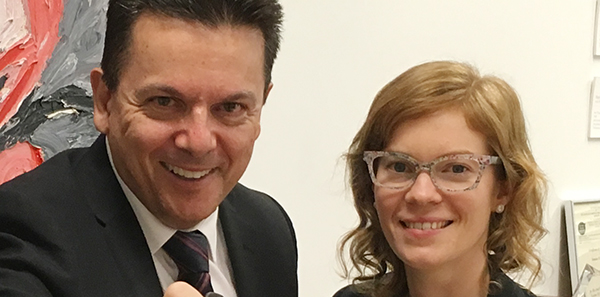1:30min

Senator Nick Xenophon and Kate Gifford
______________________________
By Kate Gifford
President
If you’ve ever wondered what happens on a visit to Parliament House, I’ll tell you. There’s an enormous amount of walking back and forward to be checked in and out from the marble foyer, even for successive meetings. You’ve got to wear comfortable shoes.
The hallowed, harried corridors are carpeted green in the MPs’ wing, red for the Senate and blue in the Ministerial wing. Polished wooden floors are pockmarked from countless busy heels. You could get lost for days in there if you didn’t have someone escorting you along the way.
Once you’ve been guided to your destination, the action begins. Your long-awaited meeting might be interrupted by a phone call, a vote in Parliament, a crisis in the electorate. For the most part we are given an opportunity to state our case and better understand the government’s or opposition’s approach to our issues.
Two action-packed days
Last month CEO Genevieve Quilty and I had two successful days in Canberra advocating for the profession.
We met with Senator Nick Xenophon (SA) and were asked to reschedule a time we had made with Senator Nova Peris (NT).
That night the Parliamentary Friends Group dinner focused on Australia’s leadership role in overseas development of eye health services.
Vision2020 Australia is a consortium of professional associations, service organisations and patient groups in our sector, and has four key areas of activity. These are early intervention and prevention; independence and participation (low vision); Aboriginal and Torres Strait Islander eye health; and global service and education delivery.
Optometry Australia is heavily involved in the first three and opportunities arise to leverage our message to the government and the public through Vision2020 support.
Genevieve and I had a busy day the next day, meeting with the Health Minister’s Senior Adviser, the Shadow Health Minister, Private Healthcare Australia, the AMA and Vision2020 leadership.
The Senior Adviser on eye health to Health Minister Sussan Ley listened as I described the four pillars of Optometry Australia’s 2016-2017 Federal Budget submission.
These are the reinstatement of indexation; restoration of 24-month frequency for comprehensive eye examination in the 40-64 year age group; establishment of a bulk-billing incentive for low income earners and children as in general medical practice; and annual comprehensive eye examinations available to Indigenous people.
In formulating this position, we had assimilated feedback from many MPs after our Petition delivery and Advocacy Day in Parliament House in October last year. They had told us that blanket reversal of our 2015 Medicare cuts was unrealistic in the current environment, and we would need to adjust our message to be successful.
At each meeting we clearly stated the impact of the cuts on patient access, practice sustainability and eye health.
Fewer patients
I explained that analysis of Medicare utilisation figures for 2015, which are only recently available, shows significantly fewer patients aged 40-64 years accessing eye examinations in 2015. There are more than 300,000 fewer, which is most likely due in significant part to the Medicare cuts.
These people are at higher risk of asymptomatic, undiagnosed eye disease. Before 2015, Medicare utilisation had been growing by around three per cent per year, so a fall in utilisation is against trend.
The statistics tell us that anywhere from 6,000 to 10,000 or more of these 40-64 year-olds who didn’t have an eye examination last year will develop glaucoma, and we know that half of the Australians living with glaucoma are unaware that they have it.
That’s worrying, as are the undiagnosed people with diabetes who aren’t eligible for an annual 10915 until diagnosis, along with the vast majority of diabetic patients who aren’t having their yearly examination.
Amongst Indigenous Australians, where 35 per cent of adults have never had an eye examination, optometry has a crucial role to play in prevention and early intervention in eye disease.
We discussed the Medicare Benefits Schedule (MBS) review with the Minister’s office, where professions are being asked to work with the government to find savings within their item schedule. An early commitment has been made by Ms Ley that around half of savings will be reinvested back into the MBS.
I made the point that the savings from the Optometric MBS have already been realised by the government, to the tune of at least $30 million in 2015, so we are obviously keen to see reinvestment in our profession.
Including projected growth, our Optometry Australia policy team has determined that the government’s saving due to our MBS cuts is closer to $50 million in 2015 in real terms.
When our profession is asking for $10 million per year for a bulk-billing incentive for low income earners, or $20 million per year to reinstate 24-month comprehensive eye examinations for 40-64 year-olds, we’re asking within our means and with respect to the government’s tight fiscal situation.
In an election year we offer the government some low-cost wins with the potential for strongly positive public sentiment.
Our 2016-2017 Federal Budget submission is readily available to download from our website.